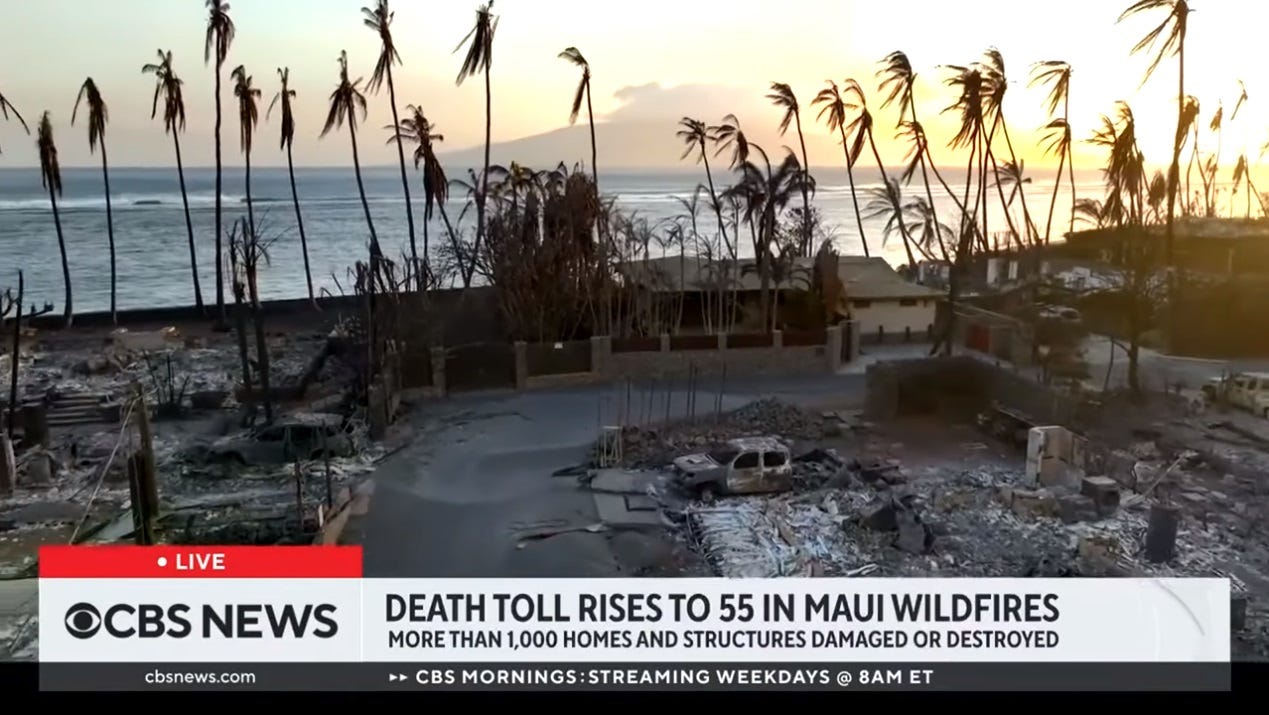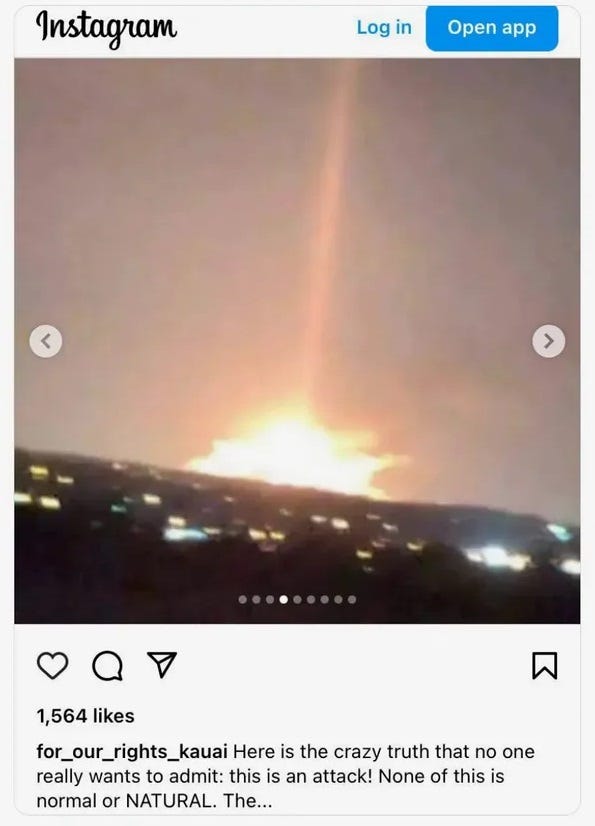Yes, Hawaii Fires Related To Climate Change. What Part Of Earth ISN'T Affected By Climate?
Fine, earthquakes, solar flares, gravity, and the evil in men's hearts.
Residents and officials in Hawaii are beginning to get a better understanding (Washington Post gift link) of just how bad this week’s wildfires were. So far, 55 people are confirmed dead, although Maui County Mayor Richard Bissen clarified this morning on NBC’s “Today” that the growing number has so far counted only bodies found outdoors and in vehicles, but not yet in the more than 1,700 buildings estimated to have been burned, mostly in the historic town of Lahaina.
“So we have not yet searched in the interior of the buildings. We’re waiting for FEMA to help with that search as they are equipped to handle the hazmat conditions of the building.”
“Right now, our focus is on finding any missing persons, we want to reunite families, we want to give people information whether their family members at one of our shelters or whether they are among those who have perished, we need to get that information to our citizens,” he said.
Edit/update: As of February 2024, the death toll is 101, down from an estimated 115 after DNA testing found that some victims were counted more than once.
Maui Police Chief John Pelletier asked residents to hold off returning to Lahaina until the bodies have been removed, and Jesus of course not. Much of the west side of Maui is still without power and cell service; more than 11,000 people have no electricity in homes that are still standing, and Hawaii Gov. Josh Green said it could take weeks or even months to return power to all parts of Maui.
Green said at a Thursday night press conference that the state has previously been hit by wildfires, but “We’ve never experienced a wildfire that affected a city like this before.”
“I think we’re seeing this in many different parts of the world, fires from California to Colorado,” Green said, noting he has been contacted by “several governors” on the impact of the wildfires and shared their experiences.
“It is difficult now in a time where global warming is combined with strengthening storms and drought,” he said, and vowed that the state would do whatever it could in its power to better anticipate such disasters. […]
“Climate change is here and it’s affecting the islands, and I think that’s what we’re seeing with this fire.”
And yeah, that’s the case. As with other extreme weather we’ve seen just this year, it’s not that we’ve never seen extreme weather previously. Rather, 150 years of making the atmosphere and the oceans warmer by pumping heat-trapping gases into the atmosphere inevitably affects the entire weather system everywhere. As the instructor of my long-ago “weather for pilots” class pointed out, Earth is a big spherical heat-moving machine, and weather is simply what happens when warmer and cooler masses of air and water interact.
That was back in 1980, when the world could have really avoided almost all the consequence of global warming by transitioning away from fossil fuels, but oil and coal companies were making far too much money to let that happen, and 43 years later more and more places around the world will see flooding and more intense storms and wildfires, because hell, we’ve kept adding heat to the planetary heat-moving machine.
In Hawaii, climate change was one of the reasons the state was primed to go up in flame, as the Guardian explains today.
Katharine Hayhoe, the chief scientist at the Nature Conservancy, said that global heating is causing vegetation to dry out, priming it as fuel for an outbreak of fire. “Climate change doesn’t usually start the fires; but it intensifies them, increasing the area they burn and making them much more dangerous,” Hayhoe tweeted.
Nearly a fifth of Maui, the Hawaiian island where the fires have occurred, is in severe drought, according to the US Drought Monitor. The island has experienced other serious fires in recent years, with blazes in 2018 and 2021 razing hundreds of homes and causing the evacuation of thousands of residents and tourists.
Experts say that wildfires in Hawaii are now burning through four times the amount of area than in previous decades, in part due to the proliferation of more flammable non-native grasses but also rising global temperatures.
Add to that the freakishly strong winds that were churned up by Hurricane Dora — a good 500 miles south of Hawaii — and all you need are some downed power lines or other sources of sparks, and there’s your island-burning wildfires. (Officials haven’t yet determined the exact cause(s) of the fires yet. No, it’s probably not arson, rightwing Twitter.) Sure, high winds, droughts, and hurricanes were all around in the past. But turning up the temperature of the whole system by trapping more heat in the atmosphere makes all those factors worse.
Not surprisingly, Fox News brought out several environmental scientists to “throw cold water on Dem claims” that climate change caused the fires, as the headline put it. Of course, they did nothing of the sort; they pointed out that the non-native vegetation was especially prone to catching fire, and while some suggested that Hawaii simply should have raked its forests more, that doesn’t change the connection between climate change and drought, either.
Fox also amplified a tweet by prominent climate change minimizer Jim Steele, who excoriated the New York Times for linking the wildfires with climate. No, he insisted, the real problem was Hawaii’s abandonment of good ol’ colonialist exploitation:
Alarmist click-bait media are the true deniers avoiding the well established science of wildfires to push the climate crisis. As Hawaii has abandoned many pineapple and sugar cane fields, invasive grasses took over. Fire experts classify grasses as one-hour fuels, meaning in less than half a day of dry weather those grasses become highly flammable.
Bizarrely, he went on to claim that Big Media “now want you to believe climate change happens in just a few [hours],” which of course no one said.
The Times did, however, note the work of Clark University climatologist Abby Frazier, who observed that that Hawaii’s drought conditions have worsened since 1990, due in part to variations in the La Niña weather pattern since the 1980s.
Another change: As temperatures increase, the clouds over Hawaii are thinner, Dr. Frazier said. And less cloud cover means less precipitation. On top of that, big storms have been moving north over time — delivering less of the rainfall that they typically bring to the islands.
All three changes are probably related to rising temperatures, Dr. Frazier said. “There’s likely a climate change signal in everything we see,” she said.
Worse, increasing seasonal wildfires have led to the spread of non-native vegetation, since some native plants aren’t well-adapted to fire. But the invasive plants grow quickly —then dry out during drought.
And yes, the end of sugar cane and pineapple plantations played a role in the spread of non-native vegetation that encroached on the former farms. That doesn’t negate climate change, it’s another consequence.
“The landscape is just covered with flammable stuff,” said Ryan Longman, a research fellow at the East-West Center, an educational institution. “All of the conditions just came together.”
Oh, yes, and we also feel compelled to point out that no, Hawaii was not the target of a directed-energy weapon, and a widely circulated photo claiming so actually shows a 2018 oil refinery fire that also is not a directed-energy weapon, Jesus twerking Christ on an electric unicycle, disasters bring out all the loons, the end.
[WaPo (gift link) / Guardian / NBC News / CNN / NYT / Snopes / Image: Screengrab, CBS News on YouTube]
Yr Wonkette is funded entirely by reader donations. If you can, please subscribe, or if you prefer, you could make a one-time donation using the button below, which sorry does not actually fire a Jewish Space Laser at Ron DeSantis’s balls.





Islands, surrounded by ocean, which is very wet, from the standpoint of water, are burning. It’s like being on a wooden ship that caught fire. I live in a rural farmland area sitting at the edge of where the NC coastal plain begins. Monocroppers have leveled forests to create farm acreage, and they deplete the soil with their practices. We have a high water table, with loamy soil, pockets of clay and sand, which is magical for farming if treated properly, but somehow they manage to turn their soil into depleted sand. It doesn’t matter what cover crop they put down because they spray it with Roundup and then till it. It’s just not enough. On any given summer day, there can be acres full of freshly sprayed, dead and dried cover crops sitting idle and awaiting tillage. Fire would race through such fields and there’s very little to stop it, despite water being only a little over a foot below. It gets oppressively hot here, and humidity puts the heat index into triple digits, but we get droughts as well as flooding. Most people out here want no trees in their yards, only lawn grass, clipped short. And they might believe in climate change, but they don’t believe they can do anything about it, and certainly aren’t interested in leaving their comfort zone in any way in order to do so. It’s always someone else’s job to fix what they broke, including the planet. Unless the governments of the world are willing to make big changes and enforce them upon the populace, we are all gonna burn. That 30% of the populace who are deplorables won’t participate or even just curb their behaviors without being forced to.
OT: I'm sure those of you on the spectrum will just love this.
We went to Savers today so I could look for some work clothes. At the register, I was making small talk with the cashier about back to school stuff, and out of the blue, she said, "We used to call kids brats. Now, it's autism." I was almost too shocked to speak, but pointed to my daughter, who was bagging our stuff, and said, "My daughter's autistic." B hadn't heard the whole thing, and I didn't want to make a scene and embarrass my daughter, so we left. I was shaking. Back in the car, it finally dawned on B what the woman had said. I just sent a message to corporate. Never, ever said stupid, ignorant things to people you don't know.